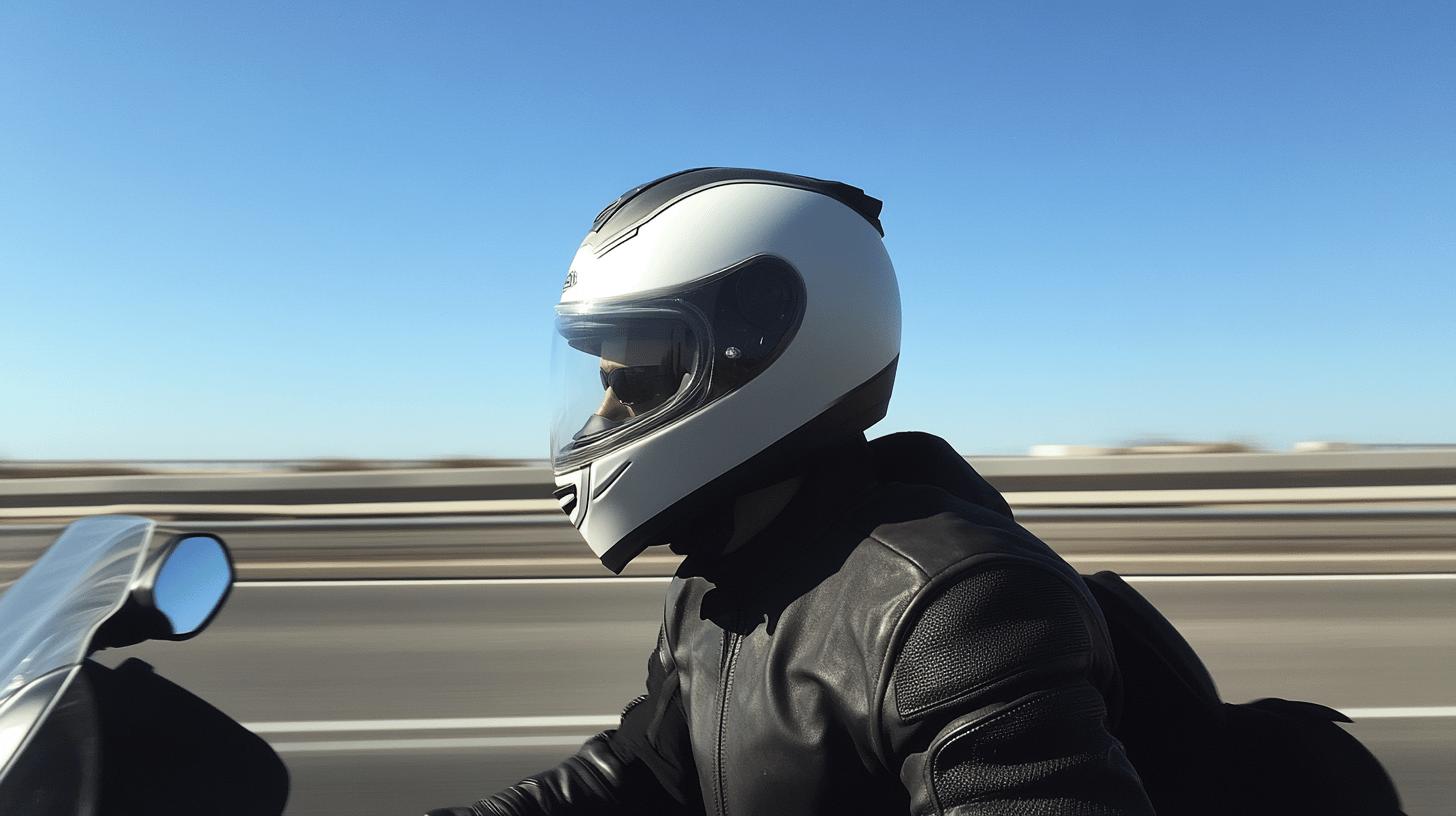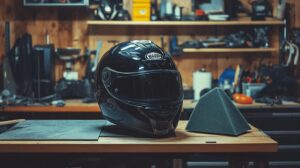Have you ever found yourself cranking up the throttle, only to be drowned in the deafening roar of wind noise seeping into your helmet?
Wind noise in motorcycle helmets isn't just an irritating distraction—it can reach hazardous decibel levels, damaging your hearing over time. With speeds over 80 kilometers per hour, it's a more significant concern than many riders anticipate.
This article delves deep into understanding the causes of wind noise and offers practical solutions to effectively minimize it, elevating both your comfort and riding safety. Buckle up as we guide you to quieter, safer rides.
Understanding Wind Noise in Motorcycle Helmets

Wind noise in motorcycle helmets can be more than just a minor annoyance; it poses significant risks to a rider's hearing and overall riding experience. When speeds exceed 80 kilometers per hour, wind noise can escalate beyond 75 decibels, which is sufficient to cause hearing damage over prolonged periods.
This auditory assault primarily results from wind turbulence, especially in the zone between the windshield and the rider's helmet. The constant roar not only affects hearing but also hinders concentration and can lead to rider fatigue, compromising both safety and comfort.
-
Wind Turbulence: The primary culprit, wind turbulence occurs as air flows around the helmet, especially at high speeds, creating noise.
-
Helmet Material: Some materials used in helmet construction are less effective at dampening sound, allowing more noise to penetrate.
-
Ventilation Holes: While essential for airflow, ventilation holes can introduce additional noise as air passes through them.
-
Fit: A helmet that does not fit snugly allows wind to enter, increasing noise levels.
-
Visor Design: Poorly sealed or aerodynamically inefficient visors can act as conduits for wind noise.
-
Riding Position: The angle and posture a rider maintains can influence how wind interacts with the helmet, affecting noise levels.
These factors collectively impact both the comfort and safety of riding. Excessive noise can distract riders, leading to potential misjudgments on the road. Therefore, addressing these causes is crucial for enhancing the riding experience by maintaining focus and ensuring auditory protection.
Steps to Minimize Wind Noise in Helmets

Reducing wind noise in motorcycle helmets is crucial not only for comfort but for safety as well. Excessive noise can lead to hearing damage and distract riders, increasing the risk of accidents.
By implementing various methods to diminish wind noise, riders can enhance their focus and sustain a more enjoyable riding experience. Effective noise reduction involves a combination of using specialized equipment and making strategic adjustments to gear and riding style.
-
Use Earplugs or Earmuffs: Invest in high-quality earplugs or earmuffs, which can significantly reduce wind noise by blocking out high-decibel sounds. Products like custom-molded earplugs can provide optimal comfort and protection.
-
Install a Windshield: Adding a windshield to your motorcycle can redirect airflow away from the helmet, reducing wind turbulence and noise. Opt for a windshield that complements your bike's design for the best results.
-
Keep the Visor Closed: Always ride with your helmet visor securely closed. This action prevents wind from entering the helmet, cutting down on noise and providing protection against debris.
-
Adjust Riding Position: Modify your riding posture to minimize direct wind impact on the helmet. A slight tuck or angle adjustment can reduce wind noise considerably.
-
Apply a Chin Curtain: A chin curtain can be attached to the lower part of the helmet to block wind from entering through the chin area, reducing noise and enhancing comfort.
-
Modify the Windscreen: Adjust the angle or height of your motorcycle's windscreen to further deflect wind away from your helmet, reducing noise.
-
Check Helmet Fit: Ensure your helmet fits snugly without gaps. A well-fitting helmet minimizes wind entry points, significantly lowering noise levels.
-
Install Noise-Canceling Devices: Consider using noise-canceling systems like the Cardo JBL 45mm Audio Set, which not only reduces wind noise but also provides clear audio for communication and entertainment.
For long-term noise reduction, regularly check and maintain your helmet and accessories. Replace worn-out components and ensure that all adjustments remain intact. Consistent upkeep ensures ongoing protection against wind noise, fostering a safer, more comfortable ride.
Choosing the Right Helmet for Noise Reduction

Selecting the right helmet is fundamental to effectively reducing wind noise while riding. The design and fit of a helmet significantly influence its ability to dampen sound and enhance rider comfort. Helmets with superior noise reduction features not only protect hearing but also improve focus by minimizing distractions, ensuring safer and more enjoyable rides.
Full-Face Helmets
Full-face helmets are highly recommended for their comprehensive coverage and noise dampening capabilities. They envelop the entire head, providing a barrier against wind entry which helps lower noise levels.
The cushioning inside full-face helmets further absorbs vibrations, contributing to a quieter ride. A snug fit is crucial; it prevents air from seeping in, reducing unwanted noise and enhancing overall safety. Models like the Shoei RF-1400 exemplify these features, combining effective sealing with comfort to create a quieter riding experience.
Aerodynamic Helmets
Aerodynamic helmets stand out for their ability to minimize wind resistance and associated noise. Their sleek designs cut through the air more efficiently, reducing turbulence around the helmet. This results in lower decibel levels reaching the rider's ears.
Helmets designed with wind tunnel testing often feature smooth contours and integrated spoilers, which direct airflow seamlessly. Brands such as Schuberth focus on aerodynamics, ensuring helmets not only reduce noise but also enhance stability at high speeds.
table {
width: 80%;
border-collapse: collapse;
margin: 20px auto;
font-size: 18px;
text-align: left;
}
th, td {
border: 1px solid #ddd;
padding: 10px;
}
th {
background-color: #f4f4f4;
}
tr:nth-child(even) {
background-color: #f9f9f9;
}
Helmet Comparison
| Helmet Brand | Key Features | Noise Reduction Rating |
|---|---|---|
| Shoei RF-1400 | Full-face, snug fit, effective sealing | High |
| Schuberth | Aerodynamic design, wind tunnel tested | High |
| Arai | Advanced cushioning, smooth exterior design | Medium |
Helmet Accessories for Enhanced Noise Reduction

Accessories can play a crucial role in enhancing the noise reduction capabilities of motorcycle helmets. While the helmet's design and fit are fundamental, adding specific accessories can further block wind entry and improve overall riding comfort.
These additions not only reduce noise levels but also enhance protection against the elements, making rides safer and more enjoyable. Selecting the right accessories tailored to individual needs and conditions can significantly impact the effectiveness of noise reduction efforts.
-
Scarves: Wrapping a scarf around the neck can effectively seal gaps where wind might enter the helmet, minimizing noise while providing warmth.
-
Wind Blockers: These are designed to cover the neck area, preventing wind from entering under the helmet. They add an extra layer of comfort and noise reduction.
-
Padded Helmet Supports: Adding padding inside the helmet can create a snugger fit, reducing spaces where wind can infiltrate and cause noise.
-
Audio Devices: The Cardo JBL 45mm Audio Set is an example of an audio device that can replace wind noise with high-definition sound, allowing riders to enjoy music or communication without distraction.
-
Chin Curtains: Installed at the lower front of the helmet, chin curtains block wind from entering through the chin area, reducing noise and enhancing comfort.
Choosing the right accessories depends on personal preferences and the specific riding environment. Riders should consider factors such as weather conditions, helmet type, and individual comfort levels when selecting these enhancements. By combining effective helmet design with strategic accessory use, riders can achieve a quieter, more comfortable riding experience.
Evaluating and Testing Helmet Noise Levels

Choosing a helmet with minimal wind noise is crucial for rider safety and comfort. Testing and reviews play an essential role in identifying helmets that offer effective noise reduction. Certified helmets with low noise levels are available across various price ranges, but understanding their capabilities requires careful evaluation.
Testing these helmets involves assessing how they perform under different conditions, such as varying speeds and wind environments. This process helps ensure that a helmet provides the necessary protection while maintaining a quiet ride. Reviews from other riders can offer valuable insights into the real-world performance of a helmet, complementing technical specifications.
-
Check Decibel Ratings: Manufacturers often provide decibel ratings for helmets, indicating the noise level experienced at specific speeds. This metric offers a quantifiable way to compare helmets' noise-reducing capabilities.
-
Read User Reviews: Feedback from other riders can reveal how a helmet performs in actual riding scenarios, highlighting strengths and potential drawbacks in noise reduction.
-
Test in Different Riding Conditions: Evaluating a helmet in various environments, such as urban and highway settings, helps determine its effectiveness in reducing noise across different wind conditions.
When evaluating helmets, consider the trade-offs between price and noise reduction features. Higher-priced helmets may offer advanced materials and design elements that contribute to lower noise levels, but budget-friendly options can still provide satisfactory performance. Balancing these factors is key to finding a helmet that meets both safety and comfort needs.
Final Words
Understanding how to stop wind noise in motorcycle helmets enhances the riding experience by addressing potential hearing damage and discomfort. Effective steps include using earplugs, adjusting gear, and selecting the right helmet.
Full-face and aerodynamic designs, coupled with smart accessories, offer enhanced noise control. Testing helmets for noise levels ensures informed choices, balancing cost and functionality.
Ultimately, these strategies lead to quieter and more enjoyable rides, reinforcing safety and comfort on every journey.
FAQ
How to block wind noise in a motorcycle helmet?
To block wind noise, use earplugs for hearing protection and adjust your riding position. A properly fitted helmet with a closed visor reduces wind entry and aids noise reduction.
How to make a helmet soundproof?
Helmets cannot be completely soundproof. However, full-face designs with cushioning, aerodynamic shapes, and accessories like wind blockers or chin curtains significantly reduce noise levels.
What causes helmet wind noise?
Helmet wind noise is caused by turbulence, material type, and design, including ventilation holes, visor shape, and how well the helmet fits the rider’s head.
How to reduce wind noise when riding?
Reduce wind noise by wearing earplugs, adjusting positions, installing a windscreen, closing the helmet visor, and choosing a helmet with sound-deadening features.
What is Helmet Wind Blocker?
A Helmet Wind Blocker is a device or accessory designed to minimize wind entry around the helmet chin or neck area, often enhancing comfort and reducing noise during rides.
Which helmets are known for low wind noise?
Shoei and HJC helmets are renowned for minimizing wind noise due to their aerodynamic designs and snug fit. Models like Shoei Neotec II and HJC RPHA 91 offer excellent noise reduction.
How to test helmet noise levels?
To test helmet noise levels, check decibel ratings, consult user reviews, and evaluate performance in various riding conditions. Balancing price with effective noise reduction features is key.

Mark Anderson is a trusted expert with over 25 years of riding experience. At 56, his deep knowledge of long-distance touring and participation in major motorcycle rallies makes him a reliable source for gear recommendations on ProtectiveGearz. Mark’s decades of firsthand experience ensure his advice is authoritative and valuable to riders seeking expert guidance.



